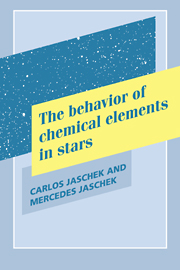Book contents
- Frontmatter
- Contents
- Preface
- Part One Content description
- A Aluminum Al to Arsenic As
- B Barium Ba to Boron B
- C Cadmium Cd to Curium Cm
- D Dysprosium Dy
- E Erbium Er to Europium Eu
- F Fluorine F
- G Gadolinium Gd to Gold Au
- H Hafnium Hf to Hydrogen H
- I Indium In to Iron Fe
- K Krypton Kr
- L Lanthanum La to Lutetium Lu
- M Magnesium Mg to Molybdenum Mo
- N Neodymium Nd to Nitrogen N
- O Osmium Os to Oxygen O
- P Palladium Pd to Promethium Pm
- R Rhenium Re to Ruthenium Ru
- S Samarium Sm to Sulfur S
- T Tantalum Ta to Tungsten W
- U Uranium U
- V Vanadium V
- X Xenon Xe
- Y Ytterbium Yb to Yttrium Y
- Z Zinc Zn to Zirconium Zr
- Summary
- Part Two Content description
- Part Three Content description
- Part Four Content description
- References
- Index of elements in stars
- Index of molecules in stars
H - Hafnium Hf to Hydrogen H
Published online by Cambridge University Press: 06 July 2010
- Frontmatter
- Contents
- Preface
- Part One Content description
- A Aluminum Al to Arsenic As
- B Barium Ba to Boron B
- C Cadmium Cd to Curium Cm
- D Dysprosium Dy
- E Erbium Er to Europium Eu
- F Fluorine F
- G Gadolinium Gd to Gold Au
- H Hafnium Hf to Hydrogen H
- I Indium In to Iron Fe
- K Krypton Kr
- L Lanthanum La to Lutetium Lu
- M Magnesium Mg to Molybdenum Mo
- N Neodymium Nd to Nitrogen N
- O Osmium Os to Oxygen O
- P Palladium Pd to Promethium Pm
- R Rhenium Re to Ruthenium Ru
- S Samarium Sm to Sulfur S
- T Tantalum Ta to Tungsten W
- U Uranium U
- V Vanadium V
- X Xenon Xe
- Y Ytterbium Yb to Yttrium Y
- Z Zinc Zn to Zirconium Zr
- Summary
- Part Two Content description
- Part Three Content description
- Part Four Content description
- References
- Index of elements in stars
- Index of molecules in stars
Summary
This element was discovered in 1923 by D. Coster and G. von Hevesey in Copenhagen, Denmark. The name comes from the Latin name of Copenhagen (Hafnia).
lonization energies
Hfl 6.6 eV, HfII 14.9 eV, HfHI 23.3 eV.
Absorption lines of HfI
The equivalent width of HfI 3616 in the sun is 0.001.
Absorption lines of HfII
The equivalent width of HfII 3505(7) in the sun is 0.024. In one FOIb star, W(3399)=0.008 (Reynolds et al 1988).
Behavior in non-normal stars
Hfl lines are enhanced in some Ba stars, which leads to large overabundances of the order of 0.5–1.0 dex (Lambert 1985, Smith 1984).
Isotopes
Hf has six stable isotopes, 12 short-lived isotopes and isomers and one isotope with a long half life. The stable ones are Hf 174, 176, 177, 178, 179 and 180. In the solar system they represent respectively 0.2%, 5%, 19%, 27%, 14% and 35% of all the Hf. The long-lived isotope Hf182 has a half life of 9x 106 years, which could be useful for radioactive dating.
Origin
Hf isotopes can be produced by several nuclear processes. Hf174 is a pure p process and Hf176 a pure s process product. The other four (Hf 177–180) can be produced by both the r and the s process.
This element is the only one found in the sun (1868, by Janssen) before being detected on earth. It was first isolated by W. Ramsey in London in 1895, and independently by P. T. Cleve and N. A. Langlet in Uppsala. The name comes from the Greek helios (sun). The history of its discovery is given by Frost (1895).
- Type
- Chapter
- Information
- The Behavior of Chemical Elements in Stars , pp. 66 - 82Publisher: Cambridge University PressPrint publication year: 1995

